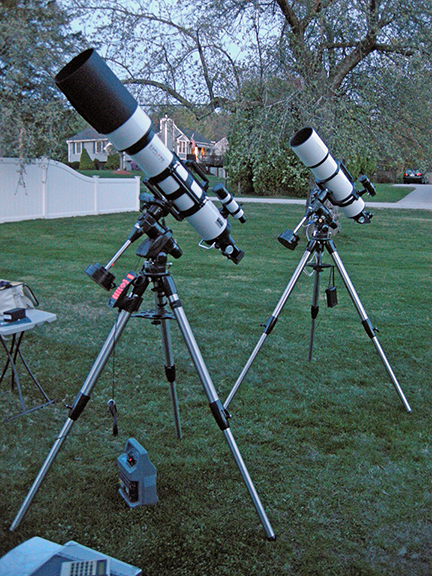
By Ed Ting
Updated 6/5/10, 1/12/17
1) Astrotelescopes AR1522 152 mm f/5.9 Refractor
2) Explore Scientific AR152 152 mm f/6.5 Refractor
3) Celestron 12" Starhopper Dobsonian
(152 mm f/5.9 achromat, OTA, rings, dovetail, carry handle, $849 net)
2) Explore Scientific AR152 6" f/6.5 Refractor
4/25/10(152 mm f/6.5 achromat, OTA, rings, dovetail, 8 X 50 finder, 2" diagonal, case, $699 net)
It's a good time to be in the market for a telescope. It wasn't that long ago that 4" was considered a sizeable refractor. These days, 5", and even 6" models are fairly common in the observing field. This fact is amazing enough, but these scopes are so affordably priced that anyone can have taste of that clean refractor viewing experience. Take, for example, the two achromats below. Club member Chase M has been using his Astrotelescope for about a year now. I've used and liked this scope and have meant to write about it. He wound up buying an Explore Scientific at NEAF this year, so we decided it was a good time to compare the two. Also present was Old Dan. Longtime readers will be familiar with this group. It's been a while since we've gotten together to test scopes, so it was nice to see the guys in action again.
The Astrotelescopes AR1522 is a 6" f/5.9 air spaced doublet achromat. There are four of these Astrotelescope AR1522s in our local club and I've grown to know it well. $849 buys you the tube and rings; you supply the rest. It's housed in a short, stubby-looking tube with a nice rotatable two speed focuser. The mechanical construction is excellent. The scope feels solid and tight, and the focuser action is just right. The coatings on the lens look nice and dark, and the lens cell has collimation screws. Like the Explore Scientific, the AR1522 appears to be well-baffled internally, a nice touch at this price point.

The Explore Scientific AR152 (L) and the Astrotelescope AR1522 (R)
The Explore Scientific refractor comes in a package that looks almost too good to be true. For $699, you get the optical tube, cradle, 8X50 finder, 2" diagonal, and a (non-rotatable) two speed focuser. Like the Astrotelescope, it has a nice carrying handle on top, but the ES adds a chrome handle near the back. Finally, you get a foam-lined aluminum carrying case. The added accessories alone could cost you a couple of hundred dollars alone. The scope looks a lot like the old Meade AR-6, not surprising since the owner of Explore Scientific is a former Meade employee. If you know your refractors, you'll recognize the tube cradle, lens cell, and chrome handle in the back as being very "Meade-like." The lens on the ES has nice deep green coatings, and its lens cell also has collimation screws.
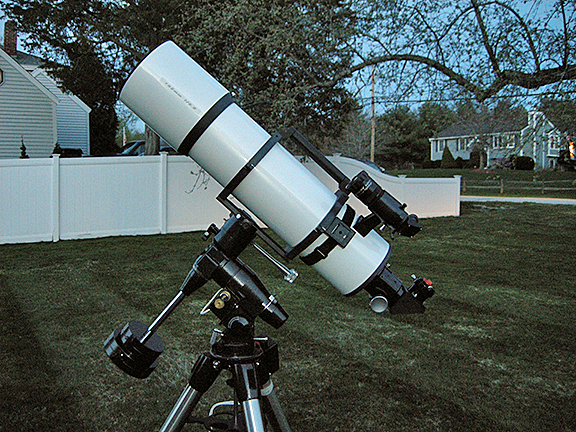
The Astrotelescopes AR1522
We mounted the scopes side by side on a clear night in southern NH. For visual use, something in the CG-5/ Sky View Pro class should be fine up to 200X or so. If you're picky, or expect to be doing serious photography, a GM-8/ Atlas or better will be required. Both tubes weigh in at or around a hefty 25 lbs, fully loaded. We used a variety of diagonals and eyepieces. For serious testing, we used the 7 mm, 13 mm, and 26 mm Naglers, as well as the 3 mm - 6 mm TeleVue zoom to help match powers. We also used some of the less expensive eyepieces from Astro Tech and Explore Scientific for casual observing. Both scopes are lookers; set either one up in a public place and you will get attention.
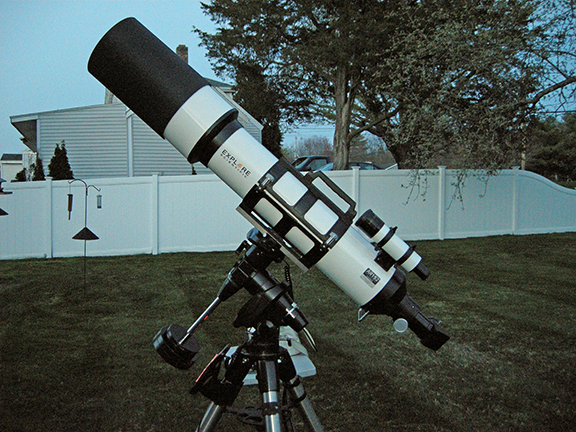
The Explore Scientific AR 152
Both scopes performed well with no glaring faults, but there were some differences. First off, I'll get the bad news out of the way. The refractors both showed false color, and plenty of it, if you knew where to look. There's no free lunch here folks - these are big, fast achromats, and you can't deny the laws of physics. If you really want to make the false color go away, be prepared to add another "0" to the prices of these scopes. The color starts becoming noticeable on 2nd magnitude objects, and you can start to see dim little purple halos on Mars and Saturn. Once you get to the brighter stars, Jupiter, and the limb of the moon, the color starts becoming hard to ignore (or hard to tolerate, depending on your point of view.) At our Messier Marathon this year, I borrowed a club member's Astrotelescope and remarked that Sirius looked like it had a bright purple headlight behind it. The owner's response was succinct: "Don't look at Sirius." Fair enough.
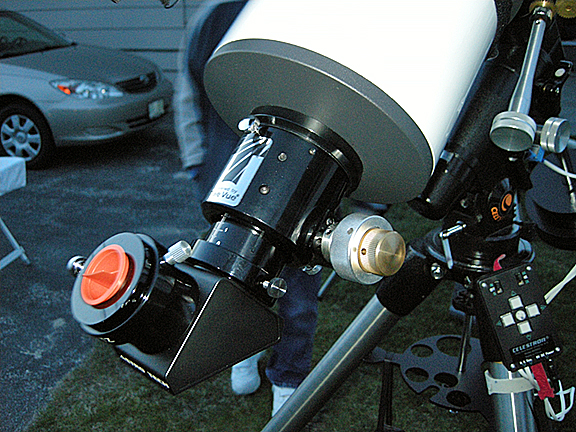
The smooth, rotatable two speed focuser is one of the nicest attributes of the Astrotelescope
We spent some time looking at Mars, Saturn, and the 1st quarter moon. Interestingly, despite having a longer f/ ratio, the Explore Scientific threw up more false color no matter what we looked at. It wasn't a big difference, but all three of us noticed it. Also, while looking at the moon, we all noticed it usually took just a little while longer to find focus on the Explore Scientific. On the Astrotelescope, there was no question - the view would simply snap into focus, no questions asked.
And so it went, down the line. On every criteria we could think of, the Astrotelescope was just a little bit better. It had a little less false color. It was a little easier to find focus. The images were just a little bit sharper. The focuser was a little bit smoother. The mechanical construction was a little more solid. Taken by themselves, none of these would amount to all that much. But add them up, and the Astrotelescope comes out the clear winner in terms of performance.
But, there's a price to pay - literally - for this performance. If you add the diagonal and finder to the Astrotelescope, your $850 optical tube is pushing $1000 or more. Comparably equipped, the Explore Scientific comes pretty much complete at $699. That 30% price difference could mean a lot, in terms of eyepieces, accessories, books, and a mount. Shop carefully, and you could come out with an Explore Scientific/ Sky View Pro package for your $1000. Beginners who might be mystified by finder and diagonal choices will find that Explore Scientific has done some of the work for them, and they may not be likely to notice (or care) about the minute performance differences.
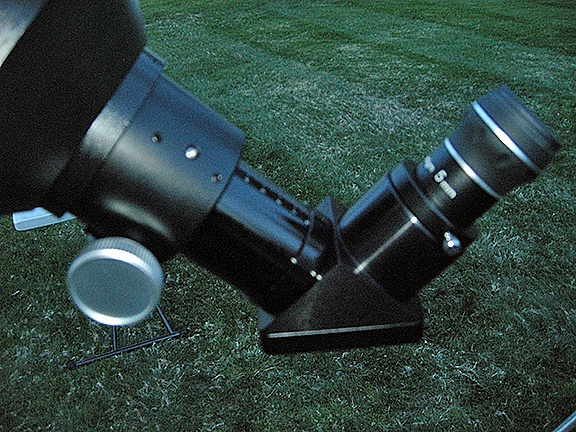
The focuser on the Explore Scientific is nice too, but doesn't rotate.
Afterwards, we used the scopes to do some general observing. We looked at some of the spring objects, and spent some time looking at Saturn with its rings almost edge-on. Both of tubes performed well. I enjoyed working with both scopes, and could happily live with either of them. If you have a premium eyepiece like a 26 mm Nagler and like to look at deep sky objects, you are in for a real treat. M81 and M82 look great framed against an inky black sky, and if your conditions are good, you can even frame nearby NGC 2976 and NGC 3077 in the same field. The 13 mm Ethos also works really well. If you can't afford the expensive glass from TeleVue, Astro Tech and Explore Scientific also offer lines of wide field eyepieces at a fraction of the cost. We used the Astro-Tech 26 mm Titan 70 degree eyepiece ($60) and while it wasn't quite up to TeleVue quality (stars near the edges became arcs instead of points) the view was good by any standard.
Both scopes excel at deep sky viewing. You get a little taste of that high contrast refractor magic. It was fun to pan around the area containing M35, M37, M36, and M38. Under dark skies, the Virgo Cluster is easy. Familiar and unfamiliar galaxies in Ursa Major whiz by as you pan around.
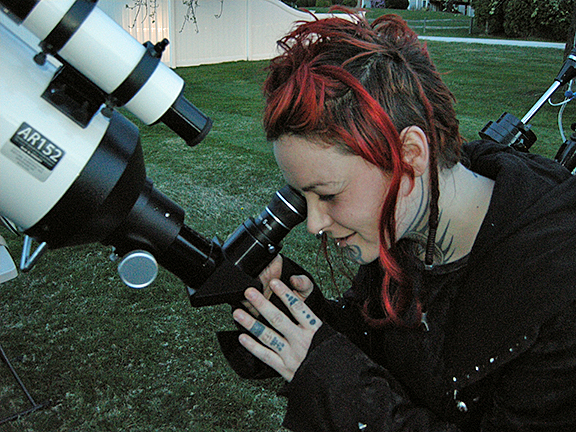
Goth girls prefer refractors
So which one should you buy? If you have the money and know how to accessorize it, it's hard to argue against the Astrotelescope. It gives up the least in terms of compromises, and is the one to get if performance is your goal. It costs more, but it's still a fraction of the cost of a 6" apo. And yet...I can't ignore the value of the Explore Scientific package. You get nearly everything you need to get started for almost no money, and the performance is still very good. And if you just can't decide, you can do what Chase did. Buy them both.
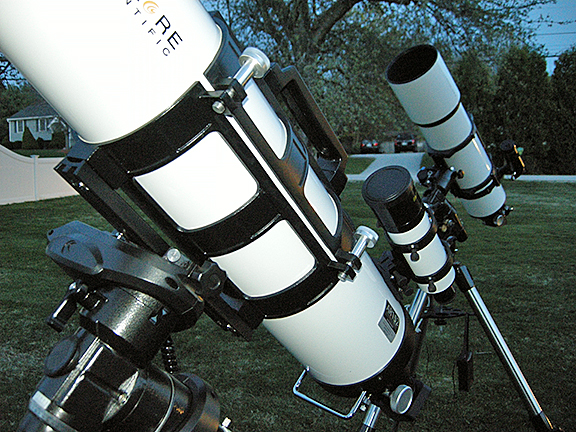
A pair of fine values, any way you look at it
Counterpoint: Notes From the Observing Field
Chase M:
"AT- I like the AT 152 scope, it is built like a tank
and although it did not come with all the needed components, what it came with
is of a better than average quality (Nice focuser and it rotates too). The
AT likes quality eyepieces and accordingly it lends itself to more than just
wide field viewing. The AT gives nice sharp high power views of the
Moon and Saturn. I have had some decent views of Mars but Jupiter is a
little too bright and color becomes an issue. With excellent contrast
finding faint fuzzies is fun again and I have found myself using the
EQ mount without the drives/clutches not engaged and just explore sharp to the
edge star fields like I would with a pair of binoculars. It has
become my second most used scope overall and the most used if you eliminate
quick and short viewing sessions with a smaller easy to carry and setup
scope. For me it a keeper.
ES- Good value for the money, comes with all the needed components except
the mount. Without comparing it to another scope, it would get a favorable
review with decently sharp views of the Moon and Saturn. Decent contrast
giving faint fuzzies good relief against a dark sky. Stars were not as
sharp to the edge with a wide field eyepiece like other scopes I have looked
through, but still a pleasing view. Color is apparent, especially on
bright objects. The ES shows the amount of color I expected to see through
the AT 152 but was pleasantly surprised to see as little color as there was.
At the price of the ES, it is the type of a scope that you might buy without
having had a chance to look through. This is a scope that will get used
but I would not call it a keeper.
If the AT had cost $850 last year when I bought it, I would probably have waited
to make the purchase until I had the opportunity to look through somebody else's AT
152."
Old Dan:
"I concur with Chase on the performance of the AT152.
I am not an achromat type of guy but was pleasantly surprised by its performance
for the price point which is the reason I purchased one. I only sold it
because its weight was becoming a personal issue. The current price point
of $849 would cause me to hesitate.
As for the ES 6" achromat, It looks like a re-branded Meade AR6.
Since the scope includes so many accessories, it is a better value at its
current sales price. However, its build quality and optics are a step
below the AT152."
Ed:
"The Astrotelescope is a better scope, but if it were me and I had to spend my own money right now, I'd have a slight preference for the Explore Scientific. Why? It costs less, you get more stuff, and the performance is still up there."
Astrotelescopes AT1522 Hots
Astrotelescopes AT1522 Nots
Explore Scientific AT152 Hots
Explore Scientific AT152 Nots
Verdict
A taste of refractor heaven for a fraction of the cost. Just beware, refractoritis is addicting and can lead to serious damage to your wallet..
3) Celestron 12" Starhopper Dobsonian 6/5/10, 1/12/17
(12" f/5 Dobsonian Reflector, 9 X 50 finder, 2" Crayford-style focuser, cooling fan, 2" 32 mm E-Lux eyepiece, $949)
At what point do our telescopes become big enough that we can start referring to them in terms of meters instead of inches? I was talking with Old Dan on this issue, and we agreed that .5 meters was the cutoff. (It's not as much fun ribbing Dan about his age these days since he moved into a retirement community.) After all, it sounds a lot better to say that I'm taking out the .5 meter, as opposed to the 20". Dan once had a 22", which translates into a .56 meter scope, and there are a couple of 25" Obsessions in the club, which are an impressive-sounding .64 meters.
So the 12" Celestron Starhopper, at .3 meters, doesn't quite make the cut. But it's still an impressive profile out in the observing field. This scope was given to me by a club member (I know, I know; it's tough being me.) He heard an all-too familiar refrain: His wife simply wanted it out of the house. He likes to do double star observing, and his tools of choice are 4"-class refractors, so it was not that big a loss - besides, clearing the space in the house meant more room for small refractors! This 12" Dob was an inconvenient behemoth to him. My perspective is a little different. I'm accustomed to hauling out the .5 meter Obsession, so the 12" Starhopper is a damsel to me.
These scopes haven been discontinued as of this writing, but they're still available from some sources, and on the used market. The scope has a familial resemblance to the Orion XT12 and the 12" Dobsonians from Zhumell, Skywatcher, and Hardin, and many of the comments that follow will apply to those scopes as well (and the Meade Lightbridge is a distant cousin to the scopes just mentioned.)
Even to a guy like me who is used to being around large instruments, the scope is big. There's no getting around it. The entire assembly weighs 80 lbs, with the optical tube carrying the bulk of the weight at around 55 lbs. You learn to move slowly, whether you're putting it together, using it, or breaking it down. The Scope Totes from Astronomy-Shoppe (see below) help a lot, but even then, there's always that nervous moment when you're setting the tube in the rocker box. Unlike the Orion XT series, where the altitude bearings sit on top of cutouts on top of the rocker box, the Starhopper's bearings sit inside, on four little nylon cylinders (two per side.) These have a tendency to unthread themselves over time, so be sure to check and tighten them once in a while. Tension is adjusted by two threaded black handles which protrude out of the sides of the rocker box. These stick out just enough that you'll run into them occasionally.
The 12" Celestron Starhopper
On the azimuth axis, the base turns on a set of roller bearings. These roller bearings are the source of much controversy. Some say they don't mind them, but I think these people are crazy. The problem with a large solid tubed Dobsonian is that the weight of the scope makes it hard to use the traditional teflon-on-formica bearing system. No matter how many teflon pieces you use, the friction always seems a little too high. The solution settled on by many manufacturers is to use roller bearings. This solves the problem of having too much friction, but it tends to solve it too well - these scopes will turn in azimuth at the slightest touch. Also, the "feel" of the azimuth changes. If you're panning around, you're dealing with two different axes that have different friction levels and different feels. If it were up to me, give me a traditional teflon-on-formica azimuth bearing anytime. One axis will be stiffer than the other, but at least the feel will be the same. There are some fixes to the problem. One is to insert felt pads between the base board and the bottom of the rocker box (see below.) This increases the friction and tends to damp out the "ball bearing" feel. Be patient, it will take some time to figure out the correct thickness of these pads for your scope.
Close up of roller bearing disc, with 3 felt pads at edges added to increase friction
The rocker box has a wide stance, and tends to flex a bit when you're moving the scope. I'd recommend reinforcing the corners of the box, either with wooden blocks or metal "L" brackets, or both. Some of the more ambitious among you toss the stock unit and built up entirely new rocker boxes using thicker plywood (I'd suggest at least 3/4" if you're going to do this) and some of your creations are quite beautiful. I envy you, my woodworking skills are modest at best. I did manage to make a rolling platform for the scope though. I leave the scope assembled in the garage on the platform, covered by a sheet to keep dust away. When I want to go observing, I simply roll the whole thing out into the driveway.
Looking down the tube
For what is essentially a bare-bones product, the scope comes nicely appointed. You get a lot for your $1000. There is a Crayford-style 2" focuser, a nice big 9 X 50 finder, and both mirrors are easily collimated. There's a 12V fan behind the primary, and it's a good thing it's back there, since the mirror can take a long time to cool down. Finally, the scope is supplied with Celestron's 32 mm E-Lux eyepiece to get you started.
I went observing several times in early May of 2010, both at home and at club skywatches. It was nice, shirtsleeve weather, just before the mosquitoes start making our observing sessions unpleasant. Like many inexpensive Dobs, the Starhopper has balance issues. The scope is front-heavy. Put an eyepiece of any substance into the focuser, and the front end wants to start tipping down on you. Even after I removed the finder, bracket, and dovetail (1.15 lbs) and replaced them with the near-weightless Rigel Quik-Finder (.17 lbs) the front end is still a little heavy. Tightening the altitude friction helps, but you can only go so far - crank down on those black handles too much and the scope becomes hard to move, and you start to get some backlash at high powers. Also, as I've hinted above, getting the mirror cool is an issue. Images are wavy and can stay that way for several hours. The cooling fan is OK I guess, but it's small, and there were times that I was wondering if there was a placebo effect going on. I found that my best line of defense was to try to keep the scope cool during the day time. That meant getting the tube out of the garage and into the house on days when I expected to use the scope. Also, I think I'm going to replace the tiny little collimation screws with something a little more substantial (various people sell these online.)
You'll want to reinforce this at the first opportunity
If it seems like I've done a lot of complaining about this scope, I haven't. These are minor issues and are all easily corrected. I tend to view all cheap Dobsonians as works in progress, and this one is no better or worse than the others out there. Beginners just need to be aware that it takes a little work on your part to make these scopes perform at their full potential. Plan on visiting your local hardware store a few times. Put another way, if the scope were perfect out of the box and weighed 35 lbs less, it would be called an Obsession, and it would cost $3000 more.
The Starhopper's mirror had a really clean star test. It was much better than I expected, showing only minor overcorrection. As Pete Smitka once told me, a 12" is the "smallest of the big scopes." Some of the dim stuff is just starting to come into view. You can see a lot with a 12" if you know how to use it and have good conditions. I spent a lot of time in and around the Big Dipper with a star chart nearby, and wound up looking at both familiar and unfamiliar galaxies for hours. On another night, I spent the entire evening around the Virgo Cluster. One of my favorite unsung objects is the "Siamese Twins" in Virgo (the numbers are easy to remember if you have a Goto system - NGC 4567 and 4568.) These two little galaxies are tipped towards each other and appear to touch at the ends, forming a heart-shaped wisp in the eyepiece. Here in NH, it takes 12" or more to appreciate this object. As the mirror takes a while to cool down, I usually had to wait until late in the evening to look at Saturn and Mars. While the views were decent, your nice refractor probably isn't going to lose much sleep.
Close up of mirror cell and cooling fan
The scope makes a good impression at public star parties. Kids see it and go, "Wow!" I brought the scope to a kindergarten and it was a big hit with the kids. The morning after, I noticed fingerprints all over the glossy black tube. Some might be bothered by this, but to me it's the sign of a scope that's well-used.
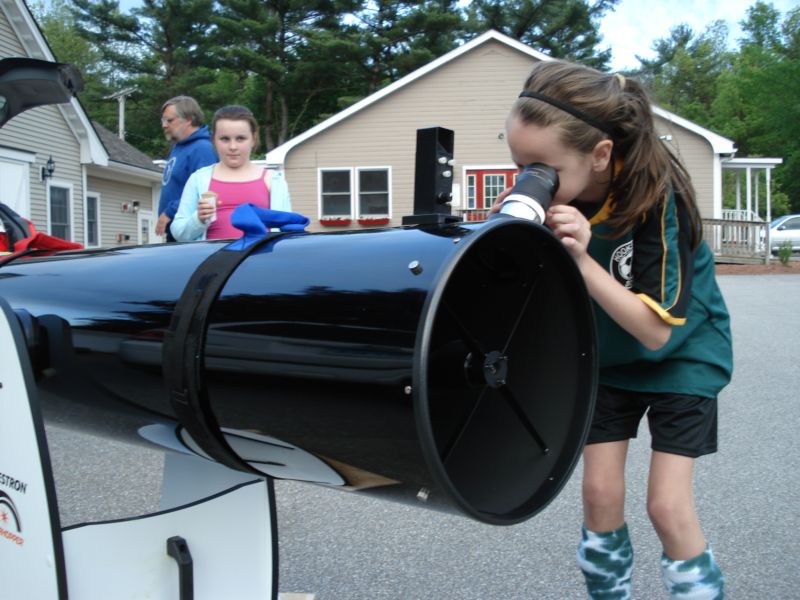
Kids like big scopes!
Inexpensive Dobsonians have a kind of simple charm that I find appealing. It isn't sexy, but the Starhopper is cheap and will show you a lot. It's a worthwhile upgrade from a smaller scope (if you already have an 8" Dob for example, the 12" buys you one extra magnitude.) It's worth looking at if you're into this sort of thing. Before making any final decisions though, check out the Orion XT12 and the Meade Lightbridge.
Celestron Starhopper Hots:
Good value
Well appointed for the price
Much cheaper than an Obsession
Celestron Starhopper Nots:
Requires a few trips to the hardware store to realize its full potential
Front heavy
Mirror cool down time
Update, 1/12/17
Through a circuitous chain of events, this scope wound up finding its way back to me 6+ years later. Those of you who own several scopes are familiar with this phenomenon. The Starhopper has seen better days. The rocker box is in sad shape. The ground board is warped, and the sides of the rocker box bow outwards noticeably when you place the tube on it. Someone has put weighted magnets on the back in an effort to balance the tube. Most seriously, a piece of the mirror cell - a metal piece - has sheared off and needs to be welded back together. Thus, the mirror will not stay in collimation. A quick comparison with someone's XT12 shows that the Starhopper uses thinner pieces on its rocker box boards, which likely contributed to the problem. As of this writing, the scope is at a club member's house, awaiting rehab. More later.
End Telescope Reviews, Page 26